5 Resume Formats That Will Dominate 2025 (And 3 That Are Now Obsolete)
In 2025, using an outdated resume format can instantly disqualify you from job opportunities.
What worked just a few years ago might now be actively hurting your chances of landing interviews. Why? Because the hiring landscape has dramatically evolved:
- AI-powered screening has replaced manual resume reviews
- Competition has intensified with global remote work
- Employers now use different criteria to evaluate candidates
The harsh reality: Many qualified professionals are being filtered out before a human ever sees their application.
But there’s good news. By understanding which resume formats now dominate the job market, you can ensure your application rises to the top of the pile.
This article reveals the five resume formats that work in 2025 and the three obsolete approaches you should immediately abandon. We’ll show you not just which formats succeed, but why they work and how to implement them for your specific situation.
Before diving in, take a moment to apply The So-What Test to your current resume. This simple evaluation will help you understand if your resume is truly making an impact or just taking up space.
☑️ Key Takeaways
- Five modern resume formats now dominate in 2025 — Enhanced Chronological, Strategic Hybrid, ATS-Optimized, Visual-Strategic, and Skills-Based Hybrid — each tailored to specific career stages, industries, and job search scenarios.
- Obsolete formats like Pure Functional, Text-Heavy Traditional, and Generic One-Size-Fits-All resumes now hurt your chances, often getting rejected by both ATS systems and human recruiters.
- AI and remote work have transformed hiring, making format strategy essential to pass automated screenings, highlight key achievements, and compete in a global talent pool.
- Your resume must be both ATS-compliant and role-specific, combining strong formatting, strategic keyword use, and measurable accomplishments to improve interview rates and visibility.
The Evolution of Resume Formats in 2025
How did we get here? Three major shifts have completely transformed what makes a resume effective:
1. The ATS Revolution
For decades, the chronological resume dominated—a simple listing of work history reviewed by human eyes. Then came Applicant Tracking Systems (ATS):
- First-gen ATS: Basic keyword scanning
- Today’s ATS: Sophisticated AI analyzing structure, format, and content
- Current reality: Up to 75% of resumes are rejected by ATS before human review
2. The Remote Work Impact
Geographic barriers have dissolved, creating:
- Global talent pools for most professional positions
- Increased competition from candidates worldwide
- Higher standards for resume clarity and impact
3. The AI Advantage
As highlighted in a Harvard Business Review study, AI now plays a dual role:
- Screening resumes more efficiently
- Reducing unconscious bias in hiring
- Creating new standards for effective resume design
The result? A complete reinvention of what makes a resume successful. Let’s examine the five formats proving most effective in 2025’s transformed job market.
Still Using An Old Resume Template?
Hiring tools have changed — and most resumes just don’t cut it anymore. We just released a fresh set of ATS – and AI-proof resume templates designed for how hiring actually works in 2025 all for FREE.
The 5 Resume Formats Dominating 2025
1. Enhanced Chronological Format
The Enhanced Chronological Format represents the evolution of the traditional reverse-chronological resume. It maintains the familiar timeline structure that recruiters appreciate while incorporating strategic elements that optimize it for modern hiring processes.
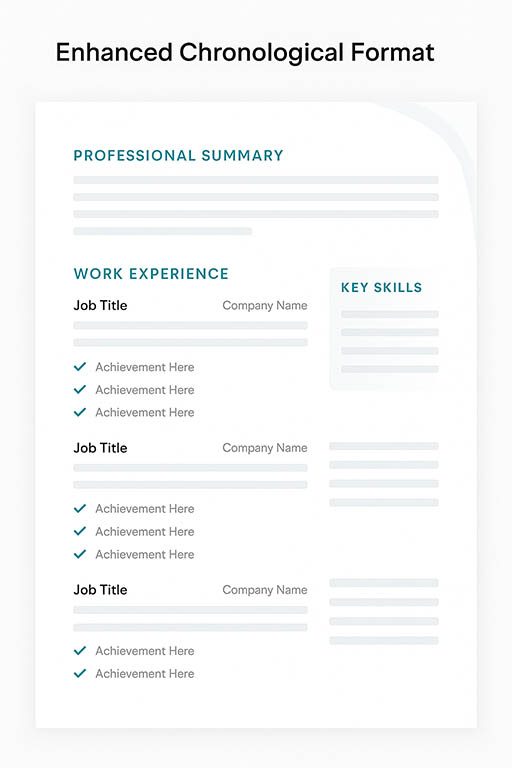
What it is: A reverse-chronological listing of your work history with strategic enhancements that emphasize achievements, metrics, and keywords relevant to your target position.
Why it works: This format builds on a structure that hiring managers are comfortable with, while incorporating elements that optimize it for ATS systems. It creates a clear career narrative while highlighting specific accomplishments that matter most to employers.
Who it’s best for: Professionals with a consistent career progression in the same industry or field. It’s particularly effective for those who want to demonstrate growth and advancement within their career path.
Key features:
- Achievement-focused bullet points with measurable results
- Strategic keyword placement aligned with job descriptions
- Clear, consistent formatting with enhanced scanability
- Strong professional summary that frames your career story
Interview Guys Tip: Quantify your achievements whenever possible. Instead of saying “Improved sales performance,” write “Increased quarterly sales by 32% within first six months.” Numbers catch both human and AI attention. Check out our guide to Resume Achievement Formulas for more examples of how to transform ordinary responsibilities into impressive accomplishments.
2. Strategic Hybrid Format
The Strategic Hybrid Format has gained significant traction in 2025 by addressing a core challenge many professionals face: how to showcase both valuable skills and relevant experience in a balanced way.
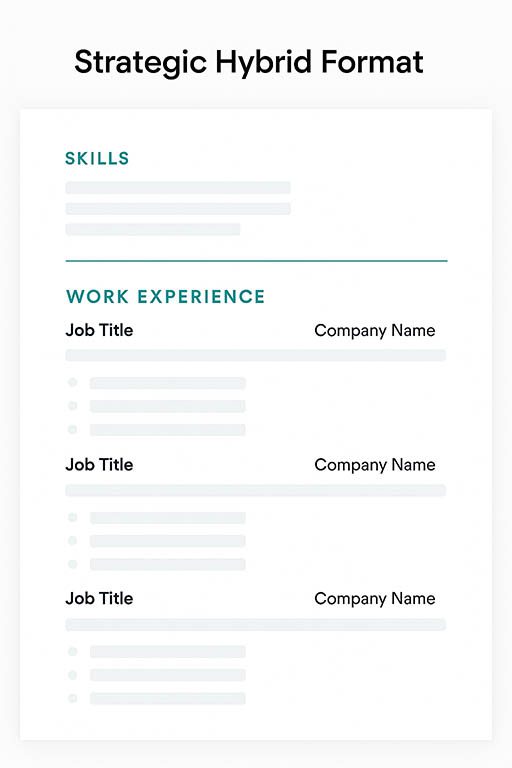
What it is: A format that gives equal weight to skills and work experience, typically leading with a robust skills section followed by a chronological work history.
Why it works: It satisfies both ATS requirements (which scan for specific skills) and human preferences (which value seeing career progression). This dual approach creates a more complete picture of your professional profile.
Who it’s best for: Mid-career professionals, career changers with transferable skills, and those with diverse experience across multiple industries or roles.
Key features:
- Prominent, categorized skills section near the top
- Traditional chronological work history that reinforces those skills
- Emphasis on transferable skills and adaptability
- Customizable sections that can be rearranged based on job requirements
Interview Guys Tip: Carefully curate your skills section to include a mix of technical, soft, and industry-specific skills that directly align with your target position. Avoid generic skills lists by consulting our guide on the 30 Best Skills to Put on a Resume to ensure you’re highlighting abilities that actually matter to employers.
3. ATS-Optimized Format
As AI and machine learning become more integral to hiring processes, a format specifically designed to work with these systems has emerged as critical for job seekers targeting medium to large organizations.
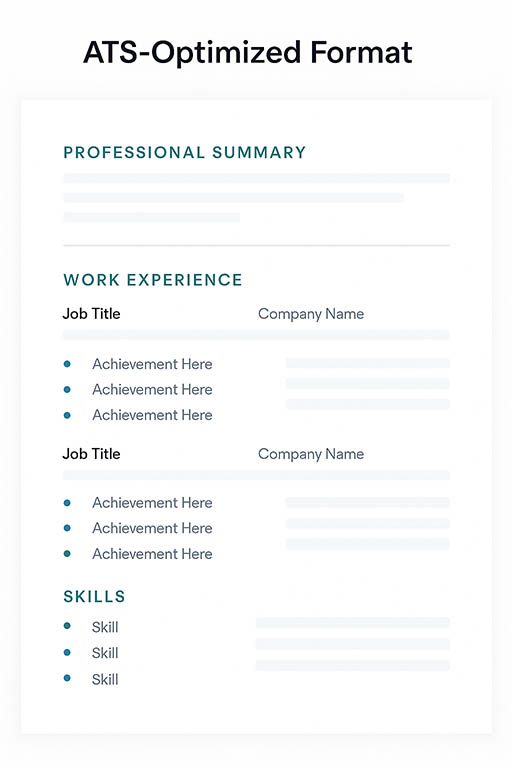
What it is: A technically structured resume designed from the ground up to perform well with Applicant Tracking Systems while remaining engaging for human reviewers.
Why it works: This format addresses the specific requirements of modern ATS systems, ensuring that your resume is correctly parsed, categorized, and ranked while still being readable and compelling when it reaches human recruiters.
Who it’s best for: Applicants to large corporations, government positions, or any organization that receives high volumes of applications and relies heavily on automated screening.
Key features:
- Clean, simple formatting without tables, columns, or graphics
- Strategic keyword integration based on job description analysis
- Standard section headings that ATS systems are programmed to recognize
- Machine-readable file formats (.docx or simple .pdf)
Interview Guys Tip: Before submitting your resume, run it through an ATS scanner like Jobscan’s Resume Scanner to identify potential issues and optimize your content for specific job descriptions. This extra step can dramatically increase your chances of making it past the first screening round.
Turn Weak Resume Bullets Into Interview-Winning Achievements
Most resume bullet points are generic and forgettable. This AI rewriter transforms your existing bullets into compelling, metric-driven statements that hiring managers actually want to read – without destroying your resume’s formatting.
Power Bullets
Loading AI resume rewriter…
4. Visual-Strategic Format
The Visual-Strategic Format represents the sweet spot between creative design and technical requirements, offering a visually distinctive presentation that still functions within ATS parameters.
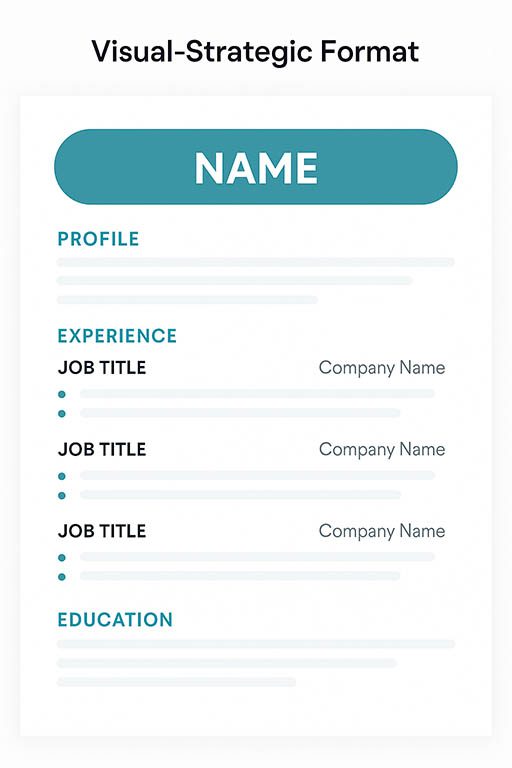
What it is: A resume format that incorporates strategic visual elements while maintaining ATS compatibility through careful design choices.
Why it works: This format captures attention in industries where creativity and design sensibility matter, while avoiding the technical pitfalls that cause many visual resumes to fail ATS screening.
Who it’s best for: Professionals in creative industries, marketing, digital media, and forward-thinking companies where visual presentation is valued as an indicator of professional capability.
Key features:
- Strategic use of color and typography for emphasis
- Clean, intentional design that guides the eye
- Visual hierarchy that highlights key information
- ATS-compatible structure beneath the visual elements
Interview Guys Tip: Even with visual elements, language matters immensely. Use powerful, distinctive language to describe yourself and your accomplishments. Our collection of 250 Powerful Words to Describe Yourself can help you select terms that convey your unique value proposition and professional brand.
5. Skills-Based Hybrid Format
The Skills-Based Hybrid Format has emerged as a powerful option for professionals in technical fields and specialized roles where specific capabilities matter more than chronological experience.
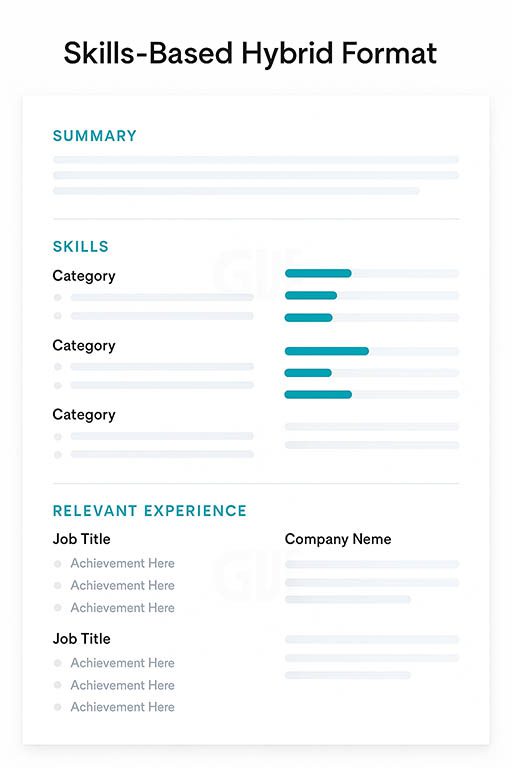
What it is: A format that leads with detailed, categorized skills sections followed by supporting work experience that demonstrates those skills in action.
Why it works: In fields where technical expertise is paramount, this format puts your capabilities front and center while still providing the work history context that validates those skills.
Who it’s best for: Technical professionals, specialists, subject matter experts, and mid-career professionals with advanced skill sets in high-demand areas.
Key features:
- Comprehensive skills sections organized by category
- Technical proficiencies with proficiency levels indicated
- Work history that reinforces and validates claimed skills
- Emphasis on continuous learning and skill development
Interview Guys Tip: This format requires a strong, focused professional summary to frame your expertise effectively. Use our Resume Summary Examples to craft a powerful opening statement that positions you as an expert in your field and sets the stage for the detailed skills sections that follow.
The 3 Resume Formats Now Obsolete
While the formats above are proving highly effective in 2025’s job market, several once-popular approaches have become decidedly counterproductive. If you’re still using any of these formats, it’s time for an urgent update.
1. Pure Functional Format
The Pure Functional Format, which organizes information by skill categories rather than chronological work history, has fallen sharply out of favor with both ATS systems and human recruiters.
What it was: A resume organized entirely around skill categories, with minimal chronological work history information.
Why it’s obsolete: Modern ATS systems struggle to properly parse and categorize information without a clear chronological structure. According to the latest ATS research, functional resumes are 70% more likely to be misinterpreted or incorrectly categorized by automated systems.
Even if a functional resume makes it past the ATS, recruiters tend to view them with suspicion. According to insights from LinkedIn’s Future of Recruiting 2024 Report, hiring managers often assume that candidates using this format are attempting to hide employment gaps, job-hopping, or lack of experience.
Who still tries to use it: Career changers, those with significant employment gaps, and professionals returning to the workforce after extended absences.
What to use instead: The Strategic Hybrid Format provides a better alternative, allowing you to highlight transferable skills while still providing the chronological structure that both ATS systems and recruiters expect.
2. Text-Heavy Traditional Format
The dense, paragraph-laden resumes that were standard in the 1990s and early 2000s have become increasingly ineffective in an era of quick digital scanning.
What it was: A text-heavy resume format with detailed paragraphs describing responsibilities and experiences, minimal white space, and dense formatting.
Why it’s obsolete: Modern recruitment practices involve rapid initial screening—recruiters now spend an average of just 7.4 seconds reviewing a resume on first pass. Dense text makes this quick assessment nearly impossible, leading to immediate rejection.
These formats also perform poorly with ATS systems, which struggle to parse detailed paragraphs and extract relevant information. The lack of strategic white space and bullet points makes keyword identification more difficult for automated systems.
Who still tries to use it: Seasoned professionals who haven’t updated their resume format in years, particularly those in traditional industries like law, academia, and some government positions.
What to use instead: The Enhanced Chronological Format provides the same comprehensive information but in a much more scannable, digestible format that works for both human reviewers and automated systems.
3. One-Size-Fits-All Generic Format
The practice of creating a single “master resume” and using it for all applications has become dramatically less effective as hiring has become more specialized and competitive.
What it was: A single, static resume used for all job applications regardless of position, industry, or company.
Why it’s obsolete: ATS systems are increasingly sophisticated in matching candidates to specific job descriptions. Generic resumes lacking tailored keywords and specific role alignment typically rank in the bottom 20% of applicants in ATS scoring.
Additionally, hiring managers can easily spot generic applications, which signal low investment in the specific opportunity. In a competitive job market, this lack of customization immediately disadvantages candidates.
Who still tries to use it: Job seekers conducting high-volume application campaigns, those new to professional job searching, and anyone taking a “spray and pray” approach to their job hunt.
What to use instead: The ATS-Optimized Format provides a template that can be efficiently customized for each application, ensuring targeted alignment with specific job descriptions while maintaining a consistent professional presentation.
How to Choose the Right 2025 Format for Your Situation
With five effective formats to choose from, how do you determine which is right for your specific situation? Consider these key factors:
Career Stage:
- Early career professionals typically benefit most from the Enhanced Chronological Format, which emphasizes education and initial work experiences.
- Mid-career professionals often find the Strategic Hybrid or Skills-Based Hybrid formats most effective, as they balance skill demonstration with work history.
- Senior executives might leverage either the Enhanced Chronological Format (to showcase progression) or the Visual-Strategic Format (to create a distinctive executive presence).
Industry Expectations:
- Technical fields like IT, engineering, and data science often respond well to the Skills-Based Hybrid Format.
- Creative industries typically value the Visual-Strategic Format.
- Traditional sectors like finance, law, and healthcare generally prefer the Enhanced Chronological Format.
- Fast-growing startups and innovative companies often appreciate the Strategic Hybrid Format.
Application Volume at Target Companies:
- Organizations receiving hundreds or thousands of applications typically rely heavily on ATS systems, making the ATS-Optimized Format essential.
- Smaller companies or specialized roles with fewer applicants may allow more flexibility for formats like the Visual-Strategic Format.
Technical vs. Creative Fields:
- Technical roles generally benefit from formats that clearly showcase specific skills and technologies (Skills-Based Hybrid).
- Creative positions often benefit from formats that demonstrate design sensibility and creative thinking (Visual-Strategic).
Remember that your resume doesn’t exist in isolation. A strong Digital Cover Letter works in concert with your resume to create a compelling application package that addresses both automated screening and human evaluation.
Implementation Tips: Putting These Formats into Action
Once you’ve selected the right format for your situation, consider these practical implementation tips:
Tools and Resources:
- Professional resume builders like Resume Genius, Canva, or Enhancv offer templates aligned with these modern formats.
- Microsoft Word provides ATS-friendly templates that can be customized to match these strategic approaches.
- Industry-specific resume examples can provide inspiration for adapting these formats to your field.
Key Metrics for Measuring Effectiveness:
- Interview invitation rate (number of interviews secured per applications submitted)
- ATS scoring (if available through services like Jobscan)
- Feedback from recruiters and hiring managers
- Time to first response after application submission
A/B Testing Your Resume:
- Create two versions using different formats
- Apply to similar positions with each version
- Track response rates to identify which performs better
- Refine the more successful version based on results
Converting Existing Resumes:
- Start with a clean template rather than trying to modify your existing document
- Extract and categorize your current content (skills, experience, education)
- Reorganize information according to your chosen format
- Add missing elements required by your new format (metrics, achievements, etc.)
- Optimize language for both ATS keywords and human impact
Conclusion
As we navigate 2025’s competitive job market, your resume format is not just a matter of personal preference—it’s a strategic decision that directly impacts your career opportunities. The five formats highlighted in this article—Enhanced Chronological, Strategic Hybrid, ATS-Optimized, Visual-Strategic, and Skills-Based Hybrid—represent the most effective approaches based on current hiring practices and technologies.
Meanwhile, the obsolete formats—Pure Functional, Text-Heavy Traditional, and One-Size-Fits-All Generic—now actively hinder your chances of success and should be immediately abandoned.
Remember that while format creates the foundation, content quality ultimately determines your resume’s effectiveness. Choose the format that best showcases your unique qualifications, then invest time in developing compelling, achievement-focused content that demonstrates your value to potential employers.
In today’s rapidly evolving job market, your resume format can be the difference between getting noticed and getting overlooked. Make sure yours is working for you, not against you.
Still Using An Old Resume Template?
Hiring tools have changed — and most resumes just don’t cut it anymore. We just released a fresh set of ATS – and AI-proof resume templates designed for how hiring actually works in 2025 all for FREE.

BY THE INTERVIEW GUYS (JEFF GILLIS & MIKE SIMPSON)
Mike Simpson: The authoritative voice on job interviews and careers, providing practical advice to job seekers around the world for over 12 years.
Jeff Gillis: The technical expert behind The Interview Guys, developing innovative tools and conducting deep research on hiring trends and the job market as a whole.
